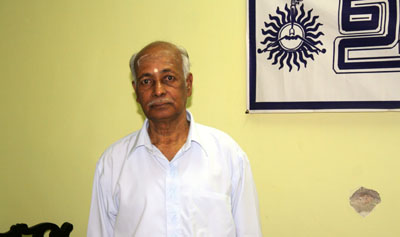By Robert Mahoney

JAFFNA, Sri Lanka
M.V. Kaanamylnathan hasn’t left his office for four years. Sri Lanka’s civil war is over but the editor-in-chief of the Tamil daily Uthayan still thinks it’s unsafe to venture out. He’s become famous among the island’s media community for his self-imposed house arrest. The colonial-era compound housing the editorial offices and printing press are guarded, but not especially tightly, reflecting an easing of tension since the defeat of Tamil secessionists in May 2009.
More in This Report
• No peace dividend for press
• Still failing a year later
• Database of murdered
Sri Lankan journalists
But Kaanamylnathan is taking no chances. He has been with the paper since it started in the mid-1980s and his journalism has angered many on both sides of the war that pitted the majority Sinhalese government against the separatist Liberation Tigers of Tamil Eelam (LTTE). To remind everyone of the dangers the paper has faced, he has not plastered over the bullet holes in his office walls from a May 2006 attack that killed two employees.
“I am staying here in office for the last four and half years,” Kaanamylnathan told CPJ, his fast-flowing Tamil-inflected English punctuated by the lazy beat of an old-fashioned printing press in the next room. When he last walked the narrow streets of this former Tamil stronghold, which has changed little in the 60 years since British rule, he was knocked down by unidentified men in a van—an event he says was a hit-and-run attempt on his life. He was seriously injured in the attack and was evacuated to Europe for medical treatment.
“We have been targeted and I don’t think that position has changed,” he said. “They may take their revenge.” When asked who “they” are, Kaanamylnathan grows pensive. “Paramilitary elements or army might take revenge,” he says. “I am writing against the government.”
The wounds from 26 years of civil war are still raw, especially in the north and east of the island where the army remains in control. Up to 100,000 Tamils uprooted by the fighting, referred to as internally displaced persons, or IDPs, are still in camps. Huge swaths of the north, designated by the military as high security zones, have been cleared of farmers and villagers. Thousands of young male Tamils who disappeared during the war are still unaccounted for.
These and other grievances are off-limits for most journalists writing in Tamil. Jaffna is the base for three of the island’s four main Tamil-language dailies but only Uthayan has been consistently targeted by gunmen. “We have to be careful to avoid writing something which is not palatable to the army,” Kaanamylnathan said. “There is self-censorship, I would say that affects 10 to 15 percent of what we publish. … The rights of the Tamil people and high security zone—there are so many things.”
Across town, N. Vijayasuntharam, editor of the Tamil daily Vaalumpuri, is equally cautious.
“The paper has not been threatened, but I know it could happen,” he told CPJ. “That is why we don’t tackle controversial subjects. … For example, IDPs are off-limits,” said Vijayasuntharam, who called self-censorship a matter of “self-preservation.”
S.P. Samy, publisher of the daily Thinakkural, says his editors have to work out for themselves just how far they can go. “The rules are not in writing,” he told CPJ. But it irks enterprising journalists to avoid burning public issues such as the refugees because they fear retribution. Thinakkural couldn’t report on the IDP camps, so instead it launched an appeal to help individuals displaced by the war. Its readers got the point.
With all this editorial self-restraint, Tamil journalists in Jaffna believe the threat to their newspapers has diminished, at least for now.
“The threat level is down maybe to 80 percent from 100 percent,” Kaanamylnathan said. Even so, journalists continue to take precautions such as forgoing bylines to protect their identities.
“We can’t put some stories in the paper and we can’t leave others out,” said one editor who asked not to be identified. “I get reporters calling, saying we must run their story because it came from the army. They will be in trouble with some officer if the story does not appear next day.”
Editors try to circumvent these various forms of censorship by running foreign news agency copy, and picking up stories from the Sinhala- and English-language media in the south. But even this access to independent news may be narrowing. The Colombo-based media have been under assault since a spate of violence in early 2009, including the unsolved killing of prominent Sunday Leader editor Lasantha Wickramatunga.
Tamil editors sigh sympathetically as they see what’s happening to the media in the rest of the country. “I told my colleagues in Colombo they came for my neck,” Kaanamylnathan said. “Now they will come for your neck.”
Robert Mahoney is CPJ’s deputy director.
